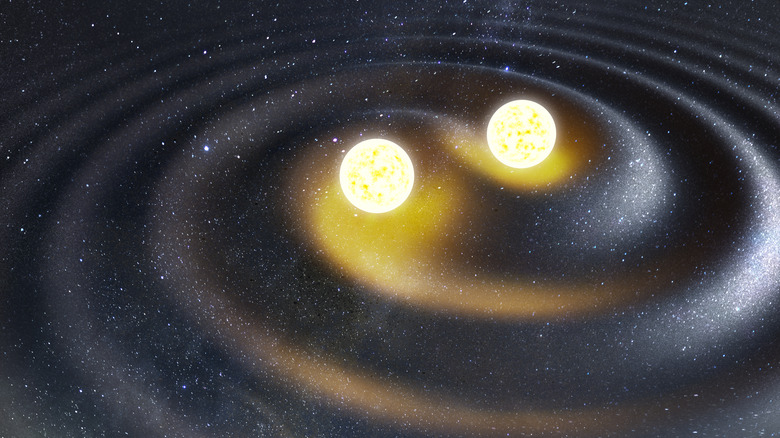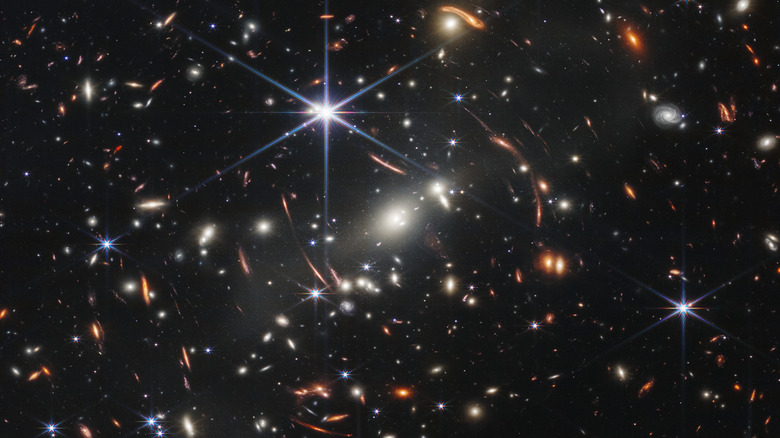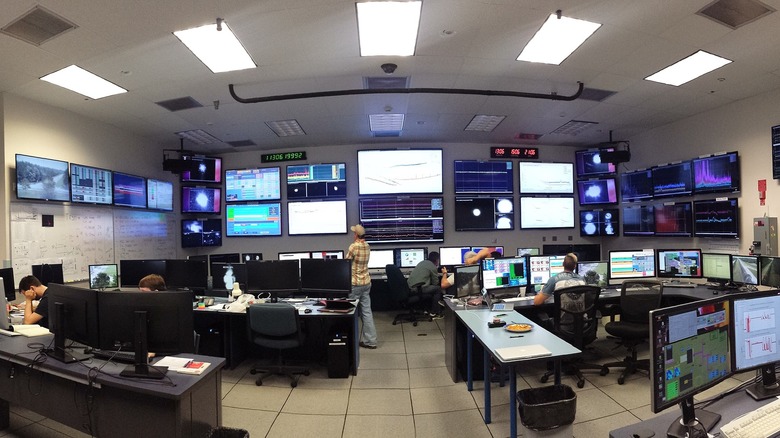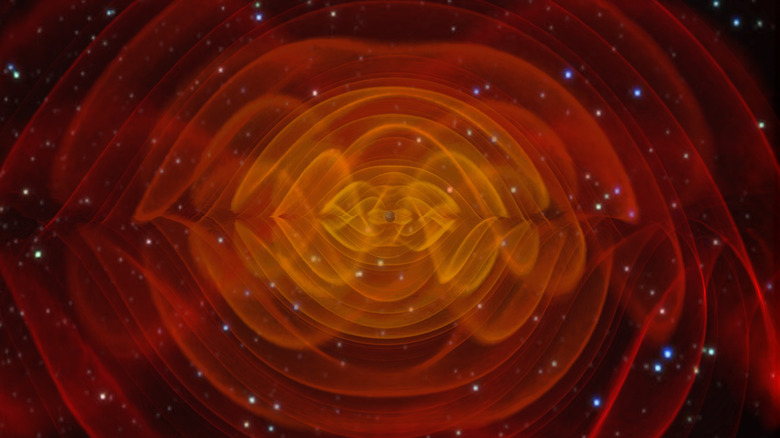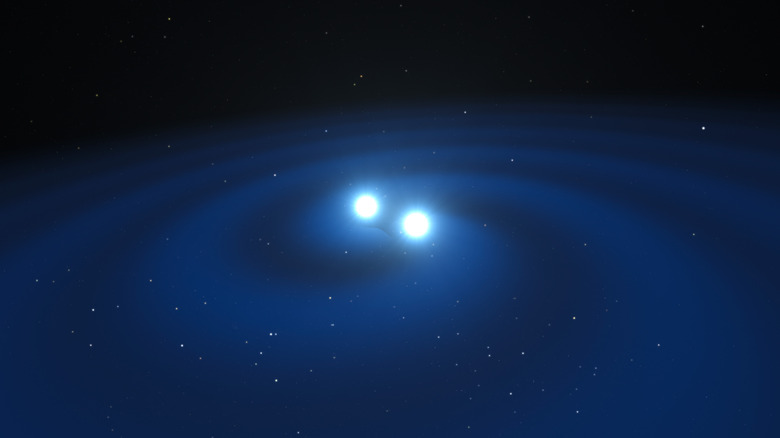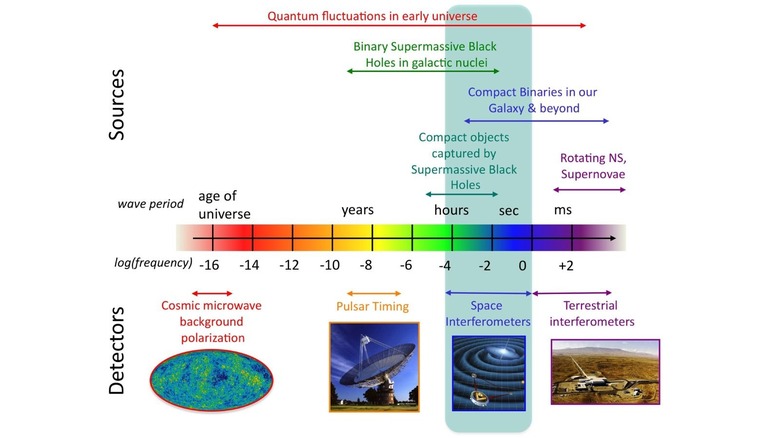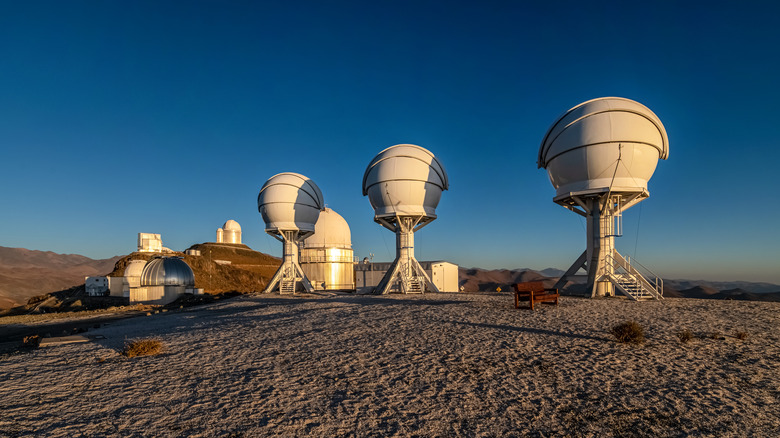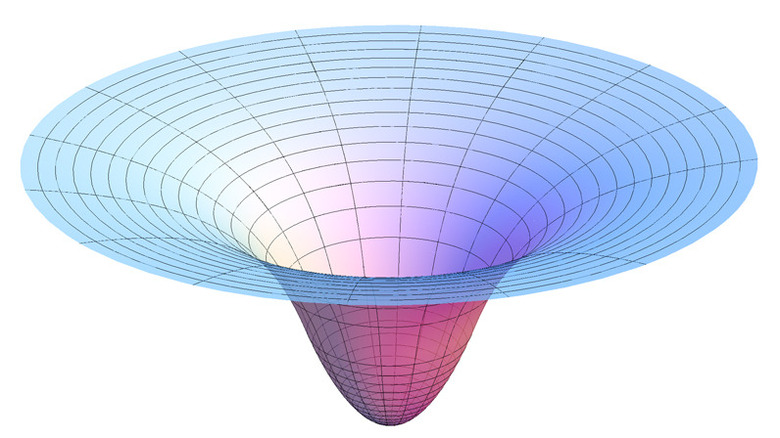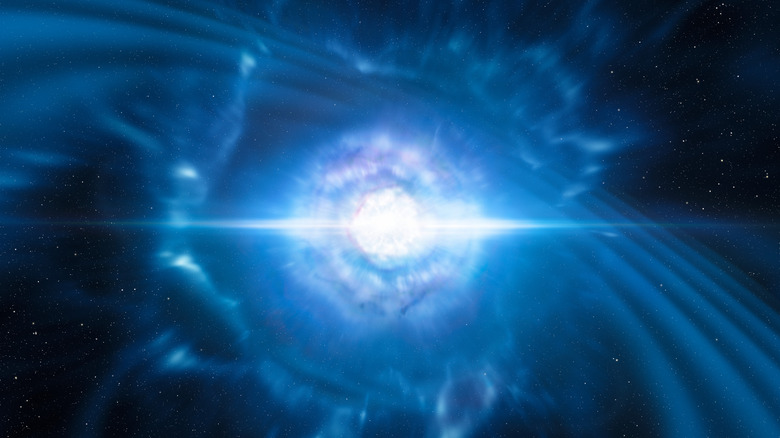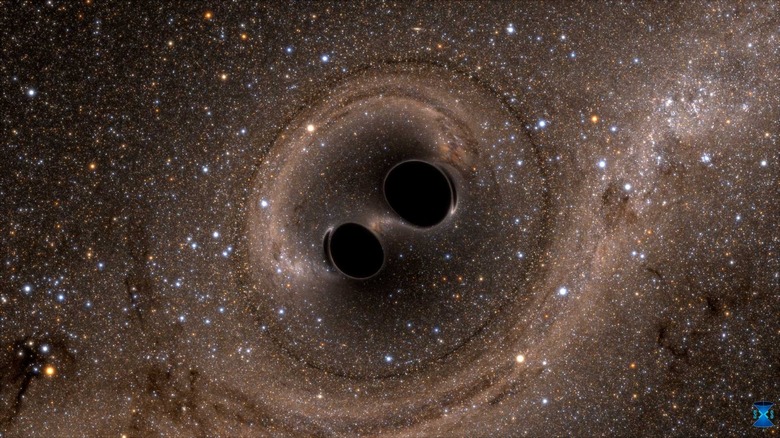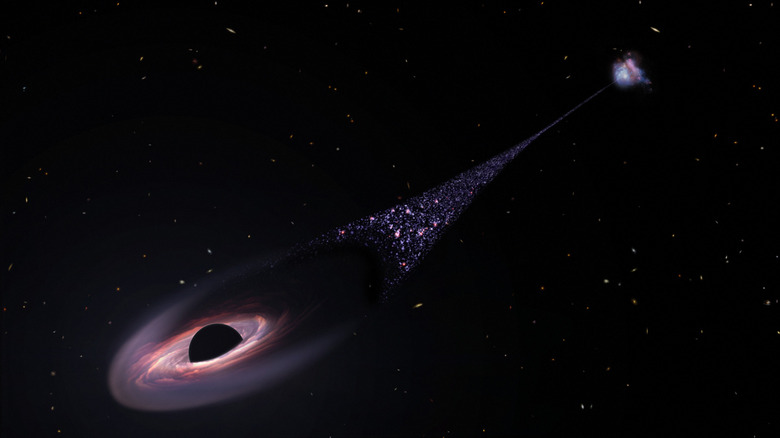Everything We Know About Gravitational Waves (And The Reason They're So Fascinating)
In June of 2023, astronomers announced a discovery that had many of them reeling with excitement. The discovery of the gravitational wave background, a vast undulating ocean of waves in the fabric of reality itself. These waves are immense, some trillions of miles long, and they're caused by the most violent and cataclysmic events in the cosmos.
Part of what made this announcement so monumental was the tremendous effort behind it: Per NASA, it took astronomers 15 years to gather all the data they needed. They needed so long because, as well as these gravitational waves being fantastically weak, they're immensely large, taking a full 30 years to complete just one cycle. What's more, being effectively completely invisible, there's no way to observe them directly. Instead of looking at the waves themselves, the team of 190 scientists across North America needed to instead look for the effects of the waves distorting space as they traveled through it.
The most exciting thing by far about gravitational waves is that they're an entirely new way for astronomers to look at the universe. Where traditional astronomy uses light (or, more generally, electromagnetic radiation) to understand the deep reaches of space, gravitational wave astronomy works by observing space itself. Despite the project taking a decade and a half, astronomers have barely begun watching the waves slowly rolling through the universe, and, as they keep looking, they may learn about things that have never been seen before.
Waves on a sea of spacetime
The concept of gravitational waves goes back over a century to 1916, when Albert Einstein published "Relativity: The Special and General Theory." In a nutshell, general relativity says that any object with mass warps spacetime, bending the fabric of reality around it, a bit like a bowling ball on a mattress. That bending causes gravity. The more massive the object, the more the distortion, and the more gravitational pull it has.
Gravitational waves (sometimes called GWs by astronomers) are a similar kind of distortion, predicted by general relativity. As massive objects accelerate through space, they cause ripples in spacetime, similar to a boat traveling over water. The catch is that they're extremely weak. The only things which can make waves strong enough to be detected are the most powerful events in the cosmos, like supernova explosions and black hole collisions.
Gravity is the weakest of the fundamental forces of the universe, and by the time gravitational waves arrive at Earth, they're so faint that they need exceptionally precise equipment to detect them. The very first such waves to be detected by scientists came from a black hole collision so powerful that, for a brief moment, it released more energy through gravitational waves than the light of every star in the universe combined. When the waves reached Earth, though, they were so weak that they had an amplitude of around a thousandth the width of an atomic nucleus.
The long hunt for gravitational waves
With the resounding success of Einstein's theories, the hunt has been on for gravitational waves for a long time. The earliest clue came indirectly in 1974, when astronomers discovered a pulsar named PSR 1913+16. Pulsars are rapidly spinning neutron stars, stellar corpses that emit regular pulses of radiation. This particular one was actually a pair of neutron stars, and astronomers found that they were slowly spiraling toward each other. Their decaying orbits meant that they needed to be losing energy, and gravitational waves perfectly explained how this was happening.
The waves themselves were first directly detected by LIGO, the Laser Interferometer Gravitational-Wave Observatory. In 2015, researchers published a paper in Physical Review Letters, reporting that they'd observed gravitational waves resulting from a pair of merging black holes. A landmark in astronomical history, the discovery led to the 2017 Nobel Prize for physics.
The new discovery of the gravitational wave background is another such landmark, proving what astronomers have long expected — that gravitational waves are constantly rippling throughout the universe. To detect something so subtle, astronomers used the International Pulsar Timing Array, a big scientific collaboration that watches a set of pulsars distributed across the Milky Way, trying to spot any slight fluctuations in their pulses. This effectively allowed researchers to make an antenna the size of the entire galaxy, which is necessary for detecting waves of such immense size.
[Featured image by Amber Stuver via Wikimedia Commons | Cropped and scaled | CC BY-SA 4.0]
Ripples on the surface of the universe
The gravitational wave background is essentially noise made by cosmic events across the entire universe. While the first waves detected came from a sudden loud event, scientists describe the background as "more of a background murmur," like a quiet and indistinct sound coming from all directions. Unraveling where exactly all of those waves may be coming from, though, is quite a task.
Much of it is probably caused by merging black holes. It's a big universe out there, with a colossal number of supermassive black holes, and the gravitational wave background very likely contains fingerprints from thousands, even millions of them, crashing together and making waves that can be felt across the cosmos. Many of those black holes are likely still unknown, having not yet been observed by astronomers by conventional means. As astonishing as this may sound, these are not the most exciting possibilities.
Some of the gravitational wave background could be leftover noise from the early universe. According to MIT, these primordial gravitational waves were caused by wrinkles in the universe itself, while it was sharply inflating during its first moments of existence. They would be the last echoes of the birth of the cosmos, similar to the cosmic microwave background. Perhaps the most exciting thing of all, though, is that there may be other things out there in deep space that cause gravitational waves, which no one has ever seen before — undiscovered phenomena just waiting to be found by astronomers.
The speed of gravity
According to physics, waves carry radiation (not to be confused with radioactivity). Electromagnetic radiation includes visible light, as well as things like radio waves and X-rays, and gravitational waves are a very similar concept. In effect, they are to gravity what light is to electromagnetism. This gravitational radiation isn't technically the same as gravity itself, but rather is caused by gravity. Gravitational waves even share a few things in common with light, and the most obvious one is speed: The speed of gravity is the same as the speed of light — the ultimate speed limit of reality.
Another thing gravitational waves have in common with light is that both can carry momentum, meaning that they can both affect how objects in space move. It's a very slight effect, though, and it's usually barely noticeable. With more massive things, however, that effect really adds up. For the most massive compact objects in the universe – neutron stars and black holes — gravitational waves can carry away a lot of momentum, and this has the strongest effect when they're orbiting each other. When objects like these revolve around each other, gravitational waves constantly carry away energy, meaning that they gradually spiral toward each other. In other words, two black holes orbiting each other are doomed to eventually collide, gradually getting closer and closer until the inevitable cataclysm when the two smash together.
[Featured image by ESO/L. Calçada/M. Kornmesser | Cropped and scaled | CC BY 4.0]
The gravitational spectrum
Using the analogy between gravitational waves and light, both also have a spectrum. This is important, since astronomers can use different wavelengths of light to study specific things out in space. This is why NASA's Webb telescope works in infrared, to pick up the light from things that the Hubble telescope before it couldn't see at shorter wavelengths. Where stars emit visible light, infrared can be seen from clouds of warm dust in interstellar space. In much the same way, gravitational waves are emitted at different wavelengths by different cosmic objects. The shortest wavelengths come from supernova explosions, with binary black holes and neutron stars making slightly longer waves. Larger still are the waves caused by the enormous supermassive black holes lurking in the hearts of galaxies, and the longest still are expected to be leftover from the earliest days of the universe. With current technology, not all of these can be seen, and the very largest gravitational waves may be impossible to ever detect.
Theoretically, gravitational waves can exist at any frequency. At the low end of the scale, the frequencies are so low (and the wavelengths so long) that it can take decades for a single wave to pass. In theory, per Caltech, the only wavelength limit for a gravitational wave is the size of the universe itself. At the extreme opposite end of the scale, high-frequency gravitational waves can theoretically exist too, but no known astrophysical phenomena can create them.
Gravitational wave astronomy
Our ability to directly detect gravitational waves is still very much in its infancy, with only a handful of detections over just under a decade. Those discoveries, however, have opened up a brand new field of science: Gravitational wave astronomy, which allows scientists to look at the universe in an entirely new light, without actually needing light at all. Where nearly all conventional astronomy depends on the electromagnetic spectrum — from radio waves to gamma rays — gravitational waves have the potential to reveal things that can't be seen through any other means. For the sheer amount that could be learned and discovered with them, some physicists consider gravitational waves an even more important development in science than the discovery of the Higgs boson.
New observatories are currently being built, to study both the waves themselves and the astronomical objects which emit them. European Southern Observatory's BlackGEM array has a set of robotic telescopes to rapidly focus on any spot in the sky where astronomers detect gravitational waves, to learn whatever they can about whatever is emitting them. Even more ambitious is an observatory being built by the European Space Agency. The Laser Interferometer Space Antenna (or LISA for short) will be a space telescope using laser beams, spanning a distance of roughly 1.5 million miles, to cover a previously unexplored range of gravitational wave frequencies. Scientists are hoping it'll yield some exciting new discoveries.
[Featured image by Zdeněk Bardon (bardon.cz)/ESO | Cropped and scaled | CC BY 4.0]
Gravity particles
Gravitons may sound like something from science fiction, but the concept comes from real physics. Whether or not gravitons actually exist, however, is still an unanswered question. According to quantum mechanics, electromagnetic waves show wave-particle duality, which is why light can be described as a stream of photons rather than just a wave propagating through space. The existence of photons is so well established that a lot of physics would be difficult, if not impossible, to explain without them.
The idea that gravity could show a similar kind of quantum behavior is a compelling one. Compelling enough that scientists have spent entire careers working on quantum gravity in an effort to prove that it can show the same quantum traits as light. The gravity particles in this theory are known as gravitons. Per BBC Science Focus, the search for proof of gravitons is currently the biggest challenge in the quest for the so-called theory of everything — a way to unify theories of gravitation with the other fundamental laws of physics. However, while theorists widely expect gravitons to be real phenomena, they're proving to be elusive. To date, they're still hypothetical, and their existence has not yet been confirmed. As gravitational wave observations become more and more important in astronomy, perhaps they may help to finally answer whether or not gravitons truly exist.
[Featured image by AllenMcC/Wikimedia Commons | Cropped and scaled | CC BY-SA 3.0]
The infant cries of a newborn universe
In the earliest moments in the history of the universe, everything that existed went through a phase known as cosmic inflation. In the blink of an eye, the cosmos ballooned from microscopically small to astronomically large. Per MIT, theories predict that at the same time, the first gravitational waves resounded through the newly formed universe. At first, these were created by tiny quantum fluctuations, but were stretched and amplified as the universe expanded. Just shy of 13.8 billion years old, these primordial gravitational waves, if they exist, are expected to still echo throughout the universe today. While they've still never been detected, they could give cosmologists a glimpse at the beginning of everything.
In fact, gravitational waves are the only way to glimpse the earliest moments of the universe. Because the entire cosmos was opaque in the beginning, it's impossible to observe it with light. The oldest light in the universe is still visible today, stretched into the cosmic microwave background, but it's impossible to see anything older. At least, not with light — gravitational waves can freely move through places where light can't, because they only weakly interact with matter. They can pass through planets and cosmic dust clouds alike, allowing astronomers to see the previously unseeable.
[Featured image by M. Alvarez, R. Kaehler, and T. Abel/ESO | Cropped and scaled | CC BY 4.0]
Shockwaves from exploding stars
Supernovae are probably the best-known of the universe's most violent events: massive stars dying in fiery explosions, which can briefly outshine the entire galaxies they call home. They've been recorded throughout human history too, like the "guest star" recorded by Chinese astronomers in A.D. 1054, which shone brightly enough that it was visible in Earth's skies during the daytime — the remnant of that supernova is still visible in the night sky today, as the Crab nebula. When it exploded, it would also have released a flurry of gravitational waves invisible and unknown to astronomers before the 21st century.
Supernovae are expected to release some of the higher-frequency gravitational waves that can be detected with existing technology, near the upper limit of what LIGO can observe. To date, however, this is still purely theoretical. No gravitational waves have ever been detected from supernovae, and the reason is most likely that they're simply too weak to register. According to the "Handbook of Gravitational Wave Astronomy," they're expected to be only "marginally visible" with the tools astronomers currently have to hand, but a nearby supernova might be easier to spot. Statistically, there should be around 1-3 supernovae in the Milky Way galaxy every century, so perhaps it's simply a matter of time. In astronomy, sadly, sometimes the only thing to do is to be patient and wait.
[Featured image by ESO/L. Calçada/M. Kornmesser | Cropped and scaled | CC BY 4.0]
Colliding behemoths
The first gravitational waves ever to be detected came from a pair of supermassive black holes colliding, releasing a truly titanic amount of energy in the process. Supermassive black holes are gargantuan, famously residing in the hearts of galaxies. The Milky Way's black hole, Sagittarius A*, has around four million times the mass of the sun, and it's quite modestly sized compared to its more distant kin. Studying how supermassive black holes merge is an important part of learning about how galaxies grow and evolve over the eons. These cataclysmic events emit lower-frequency gravitational waves which, while powerful, can also be more difficult to detect.
Studying merging black holes with gravitational waves is a major goal for many astrophysicists, for the plethora of information it could yield. This is no easy matter, however, because the waves these objects emit can have wavelengths several light years in size. But astronomers potentially have an extra trick up their sleeves when looking at massive objects like these. LIGO explains how gravitational wave observations can be used to predict when a pair of neutron stars is due to collide, by watching as their orbits begin to speed up and calculating when they're expected to reach the point of no return. While it's much easier with neutron stars, perhaps in the future, all kinds of cosmic collisions could be predicted using a similar method.
[Featured image by The SXS (Simulating eXtreme Spacetimes) Project | Cropped and scaled | CC BY 4.0]
Monsters that wander the darkness
The idea of rogue supermassive black holes aimlessly roaming intergalactic space is an unsettling one, but there's a good chance that such things really exist out in the depths of space. A strange quirk of gravitational waves, and the way they carry away momentum, is the fact that two merging black holes can experience a "kick." According to a study in The Astrophysical Journal, this can hurl the newly merged black hole away from its original location at an absurd velocity, propelling it outward at up to 2,500 miles per second. This is fast enough to completely eject a supermassive black hole from its host galaxy, and out into the emptiness of intergalactic space.
Astronomers have noticed previously that black holes are sometimes absent from places they're supposed to be, and this seems a good explanation. Even if not thrown completely out of a galaxy, a freshly-merged black hole may still be displaced from the galactic core, taking time to sink back inward. Alarmingly, this means that there may indeed be rogue black holes roaming the space between galaxies. Per NASA, astronomers have even spotted the telltale signs of this happening, reporting a trail of disrupted stars left in the wake of an ejected black hole with a mass of up to 20 million suns. There are plenty of galaxies out there that don't appear to have a central black hole, and a notable one is the Triangulum galaxy ... one of the closest to our own.
